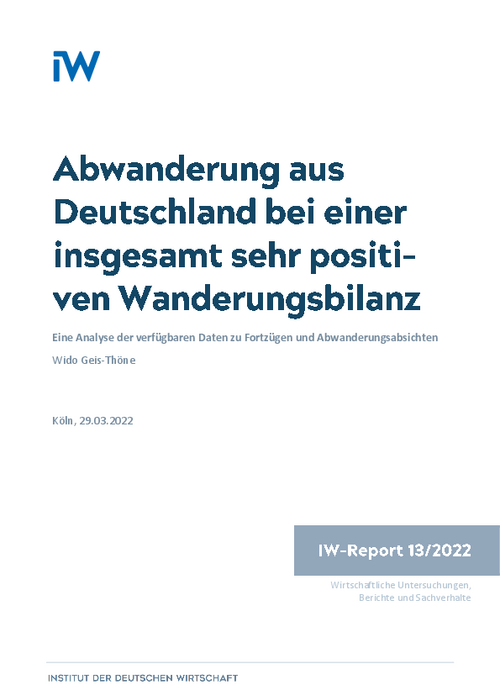Germany is an immigration country that has recorded large migration gains in recent years. However, the numbers of departures were also at a very high level in 2019 with 1.2 million and 2020 with 970,000. This is mainly explained by the fact that many forms of migration have a temporary character. Therefore, it is not necessarily to be regarded as critical.

Emigration from Germany with an overall very positive migration balance

Germany is an immigration country that has recorded large migration gains in recent years. However, the numbers of departures were also at a very high level in 2019 with 1.2 million and 2020 with 970,000. This is mainly explained by the fact that many forms of migration have a temporary character. Therefore, it is not necessarily to be regarded as critical.
However, there is a danger in this constellation that migration trends in specific qualification groups that are unfavourable for the German labour market can remain undetected for a long time and that it will therefore only be possible to take corrective action at a very late stage. For this reason, a well-elaborated monitoring of emigration from Germany is very important, especially against the backdrop of the increasing shortage of skilled workers due to demographic change.
However, this is only possible to a very limited extent with the data currently available. The official migration statistic records only very few characteristics of the people moving away. Nevertheless, it shows that the net outflow of nationals is most pronounced between the ages of 23 and 31, which can be relevant in terms of securing skilled labour. If people are lost to the German labour market in this phase of life, when they are entering the labour market and taking their first career steps, they will be lacking for a long period of time. The migration movements of foreigners can be analysed in a more differentiated way with the official statistic on foreigners. For instance, it can be found that people from the new EU member states leave Germany again relatively frequently. However, the statistic on foreigners does not give information on the educational level of the migrants, which is very important for the assessment of migration movements. The Database on Immigrants in OECD-Countries (DIOC), which is based on the population statistics of the OECD countries, shows that, at least in the past, many people with tertiary education qualifications left Germany. According to the DIOC, in 2015/2016 the proportion of highly educated people born in Germany and aged between 25 and 64 who lived in other OECD countries was 48.0 per cent, compared to only 29.2 per cent of people of this age born and living in Germany. Against this background, a comparatively high proportion of academics among immigrants is necessary to keep the qualification structure in the country constant. Developing migration policy goals and measures, this must be taken into account.
In contrast to the actual number of departures, the Socio-Economic Panel (SOEP) allows very differentiated analyses of the connection between socio-economic characteristics and the intention of people living in Germany to emigrate. However, it should be noted that many of these plans are ultimately not realised, and the socio-economic background also plays a role in their realisation. Nevertheless, the findings are very helpful for classifying emigration movements. Young adults and people with an academic career indeed plan particularly often to leave the country, as is to be expected, but usually only aim for a comparatively short stay of a few months or years abroad. Against this background, the actual migration movements of these groups are also likely to be mainly temporary, which makes them much less problematic for the long-term development of the skilled labour base. On the other hand, the shares of people who want to stay abroad permanently are particularly high in the middle age group between 45 and 49 and among the low-skilled without a vocational qualification.

Emigration from Germany with an overall very positive migration balance

More on the topic

Record immigration not only due to flight from Ukraine
In 2022, more people immigrated to Germany than ever before in the history of the Federal Republic. Around 1.46 million more people moved here than left the country, which is more than a quarter more than the previous record of 1.14 million from 2015.
IW
Immigration from Latin America: Successes and potential for securing skilled workers
Against the background of the baby boomers leaving the labour market, Germany will be increasingly dependent on skilled workers from abroad in the coming years in order to secure growth and prosperity.
IW